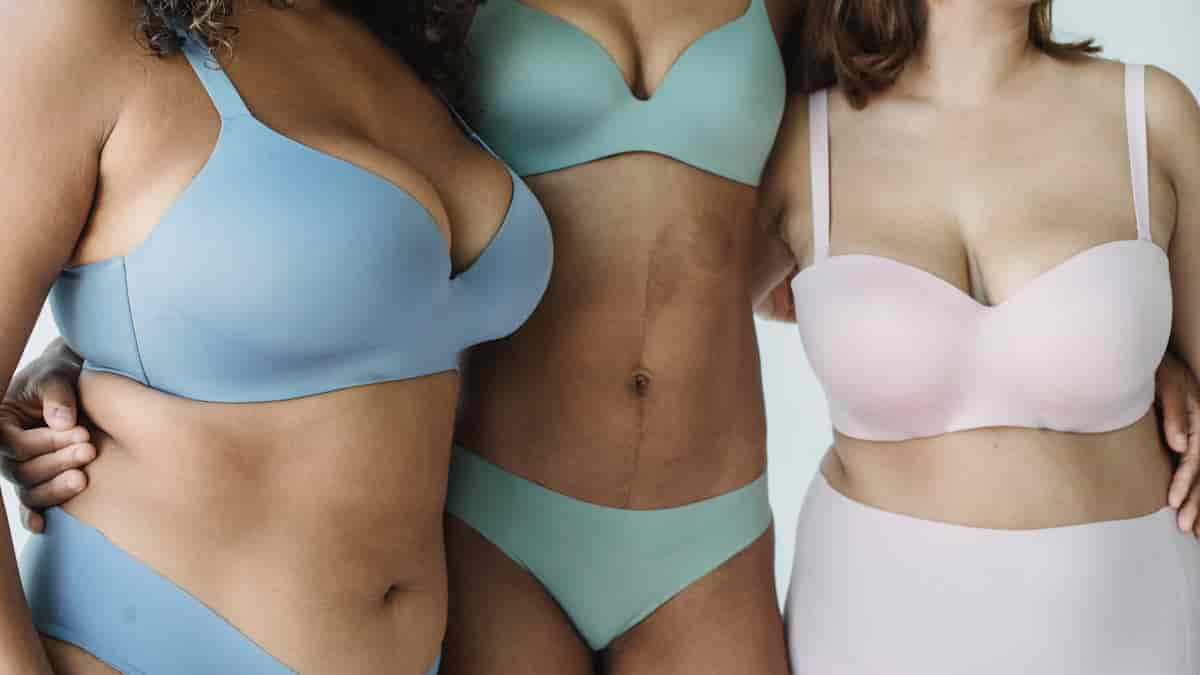Here is your complete guide to types of female underwear.
Introduction to Types of Female Underwear
Have you ever wondered why your favorite pair of underwear makes you feel so confident? Or perhaps you’ve struggled to find the right underwear to wear under that figure-hugging dress? Choosing the right types of female underwear is more than just a matter of comfort; it’s about understanding your body, enhancing your style, and boosting your self-esteem.
The world of female underwear is vast and varied. From the classic briefs to the barely-there thongs, the options can seem overwhelming. But fear not! This comprehensive guide is designed to navigate you through the myriad of types of female underwear available today, ensuring you find the perfect fit for every occasion and outfit. So, let’s dive into the intimate world of underwear and unlock the secrets to feeling fabulous from the inside out.
What is Female Underwear and Why Does It Matter?
Female underwear, also known as panties or knickers, serves several vital functions. Primarily, it provides a hygienic barrier, protecting your delicate areas from irritation and infection. Beyond hygiene, underwear plays a crucial role in comfort. The right underwear can prevent chafing, absorb moisture, and provide support.
Furthermore, underwear significantly impacts clothing fit. No one wants visible panty lines (VPLs) ruining their carefully curated outfit. Choosing the appropriate underwear style can ensure a smooth, seamless silhouette. And let’s not forget the confidence boost! A well-fitting, stylish pair of underwear can make you feel sexy, empowered, and ready to conquer the world.
The evolution of underwear has been fascinating. From simple linen cloths to the modern array of fabrics and styles, underwear has transformed from a purely functional item to a fashion statement.
Exploring the Variety: A Detailed Look at Types of Female Underwear
The world of female underwear is diverse, offering a style for every preference and occasion. Here’s an in-depth look at the major categories:
- Briefs
- Thongs
- Bikinis
- Hipsters
- Boyshorts
- Cheeky
- High-Cut (French Cut)
- G-Strings
- Tanga Briefs
- Boxer Brief
Let’s examine each style in detail:
Decoding the Details: A Comprehensive Breakdown of Each Style of Types of Female Underwear
Briefs:
- Description: Classic style with full front and back coverage. Briefs typically sit at or slightly above the natural waistline.
- Benefits: Comfortable for everyday wear, provides full coverage and support. High-rise briefs can offer additional tummy control.
- Variations: High-rise briefs, control briefs, and full briefs.
Thongs: Types of Female Underwear
- Description: Minimal back coverage to avoid visible panty lines (VPL). A strip of fabric or string sits between the buttocks.
- Benefits: Seamless look under tight clothing like leggings and form-fitting dresses.
- Types: G-strings (very minimal coverage), tanga thongs (slightly wider sides).
Bikinis: Types of Female Underwear
- Description: Lower rise on the hip with moderate back coverage. Offers a balance between briefs and thongs.
- Benefits: Versatile for various outfits, comfortable for everyday wear.
- Styling Tip: Great under jeans and skirts.
Hipsters: Types of Female Underwear
- Description: Sits on the hips with moderate coverage. Hipsters have a wider waistband that sits low on the hips.
- Benefits: Stays in place, suitable for low-rise clothing. Offers more coverage than bikinis.
- Consideration: Can sometimes create a “muffin top” effect if too tight.
Boyshorts: Types of Female Underwear
- Description: Provides the most coverage, similar to shorts. Boyshorts extend down the upper thigh.
- Benefits: Comfortable, sporty look. Can prevent chafing, especially during physical activity.
- Fabric: Often made from soft, stretchy materials like cotton or modal.
Cheeky:
- Description: More back coverage than a thong but less than a bikini. Designed to show a bit of the bottom cheek.
- Benefits: Comfortable, moderate coverage. A good compromise between a thong and full-coverage briefs.
High-Cut (French Cut):
- Description: High leg openings to accentuate legs. Sits at the natural waist or slightly higher.
- Benefits: Elongates legs, retro vibe. Can be very comfortable.
- Note: May not be suitable for all body types.
G-Strings: Types of Female Underwear
- Description: Minimal coverage, only a string in the back. The slimmest version of a thong.
- Benefits: Ideal for avoiding visible lines under the tightest clothing.
- Caution: Can be uncomfortable for some.
Tanga Briefs:
- Description: Triangular cuts of fabric in front and back, connected by strings or narrow bands at the sides.
- Benefits: Offers slightly more coverage than thongs while still minimizing VPL.
Boxer Brief
- Description: All-covering brief with short legs.
- Benefits: Nice support and comfort.
Comparison of Underwear Styles
| Style | Coverage | VPL | Best For |
|---|---|---|---|
| Briefs | Full | Likely | Everyday wear, comfort |
| Thongs | Minimal | Unlikely | Tight clothing, special occasions |
| Bikinis | Moderate | Possible | Versatile, everyday wear |
| Hipsters | Moderate | Possible | Low-rise clothing |
| Boyshorts | Full | Possible | Comfort, sporty outfits |
| Cheeky | Moderate | Less Likely | Moderate coverage with a hint of sexiness |
Choosing the Right Fabric: A Guide to Underwear Materials
The material your underwear is made from can significantly impact its comfort, breathability, and overall performance. Here’s a guide to common underwear materials:
- Cotton: Soft, breathable, absorbent, and hypoallergenic. Cotton underwear is ideal for sensitive skin and everyday wear.
- Nylon: Durable, stretchy, and has a silky feel. Often used for seamless underwear styles.
- Modal: Buttery soft, lightweight, and resistant to shrinking and fading. Modal underwear is known for its luxurious feel.
- Spandex/Elastane/Lycra: Provides stretch and conforming abilities. Usually blended with other fibers to enhance fit and flexibility.
- Lace: Adds a touch of elegance and sexiness. Often used as an overlay or trim. Requires delicate care.
- Silk: Luxurious and smooth. Silk underwear is breathable but requires special care.
Fabric Properties and Benefits
| Material | Properties | Benefits | Ideal Use |
|---|---|---|---|
| Cotton | Soft, breathable, absorbent | Comfortable, good for sensitive skin | Everyday wear |
| Nylon | Durable, stretchy, silky | Seamless styles, smooth fit | Tight-fitting clothes |
| Modal | Buttery soft, lightweight | Comfortable, breathable | Loungewear |
| Spandex | Stretchy, conforming | Enhanced fit, flexibility | Activewear, form-fitting outfits |
| Lace | Delicate, intricate | Adds elegance, special occasions | Lingerie, special occasions |
| Silk | Luxurious, smooth | Breathable, comfortable | Special occasions, luxury wear |
Finding Your Perfect Fit: Factors to Consider When Choosing Underwear
Choosing the right underwear involves more than just picking a style; it’s about finding the perfect fit. Here are some factors to consider:
- Body Shape:
- Pear-shaped: High-cut briefs or bikinis can balance your proportions.
- Apple-shaped: High-waisted briefs or control briefs can provide tummy support.
- Hourglass-shaped: Most styles work well, but bikinis and hipsters accentuate your curves.
- Rectangle-shaped: Boyshorts or cheeky styles can add volume and shape.
- Inverted triangle: Briefs or boyshorts can balance your upper body.
- Size: Always check the size chart and measure your hips to ensure a proper fit. Underwear that is too tight can cause discomfort and chafing, while underwear that is too loose can ride up or sag.
- Outfit: Choose underwear that complements your outfit. Thongs are ideal for tight-fitting dresses and leggings, while briefs are great for everyday wear under jeans and skirts.
- Occasion: Consider the occasion when choosing underwear. Lace and silk underwear are perfect for special occasions, while cotton underwear is best for everyday comfort.
- Activity: Choose underwear that suits your activity level. Breathable cotton underwear is best for workouts, while seamless underwear is ideal for yoga and Pilates.
Underwear Recommendations Based on Body Shape
| Body Shape | Recommended Styles |
|---|---|
| Pear | High-cut briefs, bikinis |
| Apple | High-waisted briefs, control briefs |
| Hourglass | Bikinis, hipsters |
| Rectangle | Boyshorts, cheeky styles |
| Inverted Triangle | Briefs, boyshorts |
Tips for Choosing the Right Underwear Fabric
| Fabric Type | Benefits | Considerations |
|---|---|---|
| Cotton | Breathable, Comfortable, Absorbent | Can shrink, May not be ideal for workouts |
| Nylon | Smooth, Durable, Quick-Drying | Not as breathable as cotton |
| Modal | Soft, Lightweight, Eco-Friendly | Can be more expensive |
| Spandex | Stretchy, Supportive, Form-Fitting | Not as breathable, Can trap moisture |
Underwear Style Guide
| Style | Pros | Cons |
|---|---|---|
| Briefs | Comfortable, Full Coverage, Supportive | Potential for VPL |
| Thongs | No VPL, Sexy | Can be uncomfortable, Minimal coverage |
| Bikinis | Versatile, Comfortable, Moderate Coverage | Potential for VPL |
| Hipsters | Stay in Place, Low-Rise, Good Coverage | Can create “muffin top” effect if too tight |
| Boyshorts | Comfortable, Sporty, Prevents Chafing | May not be suitable for all outfits |
FAQs About Types of Female Underwear
Here are some frequently asked questions about types of female underwear:
What are the most comfortable types of underwear?
Cotton briefs, modal underwear, and boyshorts are generally considered the most comfortable for everyday wear.
Which underwear style is best for avoiding visible panty lines?
Thongs and seamless underwear are the best choices for avoiding VPLs.
Read Also: Pink Plus Size Lingerie.
How do I choose the right size underwear?
Measure your hips and consult the size chart provided by the brand. When in doubt, size up.
What type of underwear is best for working out?
Breathable cotton underwear or moisture-wicking synthetic fabrics are ideal for workouts.
Read Also: Plus Size Red Lingerie.
Are cotton underwear better than synthetic materials?
Cotton underwear is more breathable and absorbent, making it a good choice for everyday wear. Synthetic materials can be better for workouts due to their moisture-wicking properties.
Read Also: Soft Wax vs Hard Wax.
How often should I replace my underwear?
Replace your underwear every 6-12 months, or sooner if it shows signs of wear and tear.
What is the difference between a hipster and a bikini?
Hipsters sit lower on the hips and provide more coverage than bikinis.
Read Also: Best Bikini for Large Bust.
Which underwear style is best for dresses?
It depends on the dress. Thongs are best for tight-fitting dresses, while briefs or bikinis work well under looser dresses.
Read Also: Best Bras for Small Bust.
Can underwear affect vaginal health?
Yes, wearing tight underwear made from synthetic materials can trap moisture and increase the risk of yeast infections. Choose breathable cotton underwear whenever possible.
Read Also: Bra Alternatives for Large Bust.
How do I care for delicate underwear?
Hand wash delicate underwear in cold water with a mild detergent. Avoid using bleach or fabric softener. Air dry or tumble dry on low heat.
Read Also: Flattering Tops for Big Busts.
Conclusion
Choosing the right types of female underwear is a personal journey. By understanding the different styles, materials, and factors that influence fit, you can find the perfect underwear to enhance your comfort, confidence, and style. Remember to consider your body shape, outfit, and activity level when making your selection.
Read Also: Best Colour Bikini for Pale Skin.
Don’t be afraid to experiment with different styles to find what works best for you. Whether you prefer the classic comfort of briefs, the seamless look of thongs, or the sporty vibe of boyshorts, there’s a style out there for everyone.
Read Also: Butter Yellow Bikini.
So, go forth and explore the world of female underwear! And remember, feeling good from the inside out is always in style.
Read Also: Brazilian vs Bikini Wax.

